
Original Link: https://www.anandtech.com/show/2558
Zalman ZM850-HP and ZM1000-HP
by Christoph Katzer on June 27, 2008 12:00 AM EST- Posted in
- Cases/Cooling/PSUs
Introduction

Today we will be looking at Zalman's power supplies that come with heatpipe cooling. Yes you heard right; Zalman wouldn't be Zalman if they didn't try to put heatpipes anywhere they fit, and now we have the first and only power supplies with heatpipe cooling. Not that it's really necessary to include heatpipe cooling in a power supply, but Zalman is big on marketing and this should certainly garner some attention. Not only does it look cool, but it also brings a new innovative touch to the boring appearance of the power supply market. Yes, the power supply is getting quite long with these extra coolers but they fit well and actually help with the cooling.


Both power supplies are equally equipped and differ mostly in terms of the combined power. It seems to be the same as the Antec Quattro which we tested last year. We recommended at that time to go for the smaller version with 850W because the 1000W unit didn't really bring many advantages with it. We will see later on in the tests if things are the same with these two units today. Even though we have 10 to 15 amps more on the 3.3V and 5V rails, the combined power of the 1000W unit is not too far away from the combined power of the 850W version. With the six 12V rails the same, there we have just roughly 200W more with the 1000W unit. Besides the numbers, we have a detailed description of where the 12V rails are going and what they will power up later. This not only helps reviewers, but it also helps end-users make sure they connect everything optimally.
Package and Appearance

The package is very large and fortunately there is a handle in the top of it. Opening the box reveals two smaller boxes inside, the first of which contains the power supply and the second the extra cables, screws, and accessories. The two packages differ from their color on the bottom of the front-side.



The power supply is very long as we stated already. This comes from the extra heatsinks, which are connected to the real heatsinks on the PCB through heatpipes. There is a 140mm fan mounted on the bottom of the power supply to move air through the case. The units have been coated with a mirror-like dark color which makes it easy to leave finger prints and scratches. The whole back is perforated for maximum exhaust, and you can see the extra heatsinks behind the small holes.

Next to the main harness coming out of the power supply there's a small switch labeled "standby noise suppressor". This switch is supposed to help reduce the noise while the PSU is switched off in standby mode. We tested this function and didn't really find a need for it. If the switch is in the ON position the noise is higher than in OFF mode. Even more important is that if the switch is switch on the power consumption of the unit goes up to 4W instead of the 1.9W while the switch is off. Our conclusion if you own this power supply: leave the switch off.
Cables and Connectors

The front features the cable management system with two PCI-E connectors, three jacks for harnesses with Molex connectors, and three jacks for harnesses with SATA connectors. This is necessary since the SATA harnesses need additional 3.3V rails for modern hard drives.

There are several harnesses already connected to the power supply and more can be attached if needed. The main harnesses such as 24-pin, 4-pin, 8-pin and two 6-pin PEG connectors are already pre-installed. There is also one harness each for SATA and Molex connectors fixed to the power supply. The user can add two more 6-pin PEG connectors and three harnesses each of SATA and Molex connectors. The total makes a very nice sum of connectors on disposal for the user. Both the 850W and 1000W unit have the same number of connectors and same length of harnesses. This again raises the question of whether the 1000W unit is really necessary.
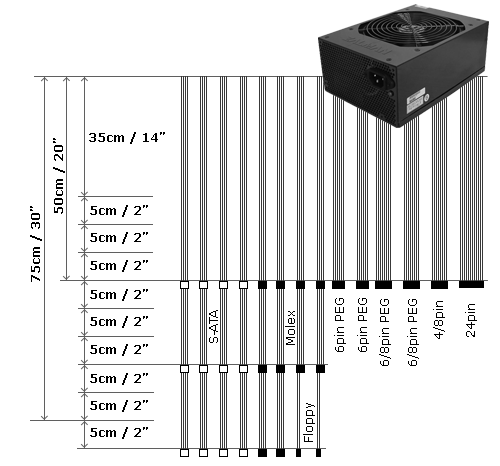
The Fan

Zalman installed a very large 140mm fan with double ball bearings. The fan is rated at 0.26A.
Internals

The inside is long… very long. We haven't seen such a long power supply since our time with the Enermax Galaxy. The heatsinks are very small and there are no fins cut out from the aluminum block. This leaves much room for the air to travel through directly the PCB and cooling everything openly placed. This is actually a very nice setup and it looks pretty clean. Most of the heat is transferred to the front with the installed heatpipes. There is no doubt that this unit is actually made by Enhance, who delivers one of the best power supply designs at the moment.
The filtering stage is well built and goes from the top over the right corner to the upper right side. The two rectifier bridges carry a funny looking heatsink, resembling a TV antenna from the old days. The two main-caps are made by Matsushita (Panasonic) and rated at 420V and 270µF. There are two main transformers and a small one for the 5Vsb circuit. The secondary capacitors are made by Teapo, a common friend nowadays in power supplies. There are two thermal sensors on the right and left side of the secondary heatsink which are connected to the fan control.
DC Outputs
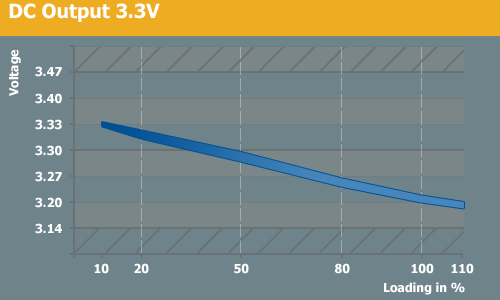
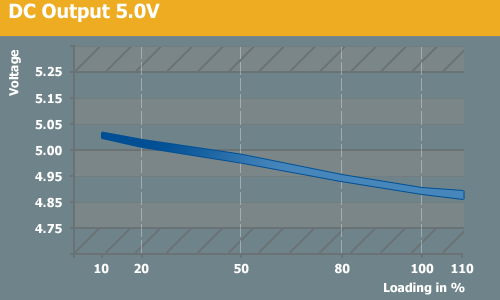
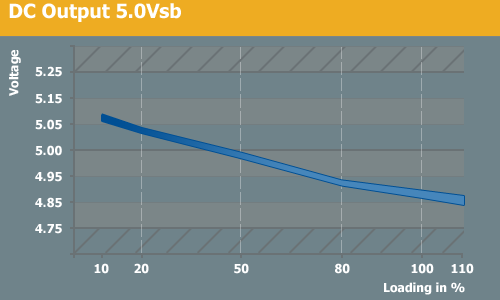
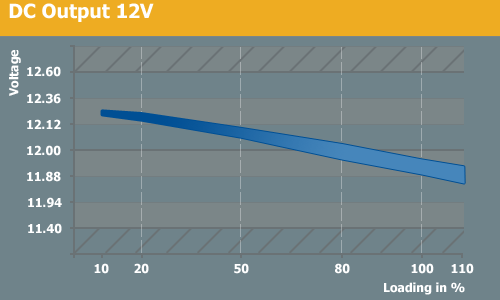
Looking at the results of the DC output, we have to say that this is not a great performance. Every rail shows a high drop of at least 3 to 4% - this is of course still within the specification but not ideal. The problem might lie with the six 12V rails that will in most cases not be connected all together. If you load all of the six rails exactly according to the diagram it will look better but if you connect only three of the rails for example it will look similar to the above graphics. The 12V rail doesn't look too bad and has a deviation of up to 3%, but the lower voltage rails have a wider range of a little more than 4%.
Efficiency and PFC
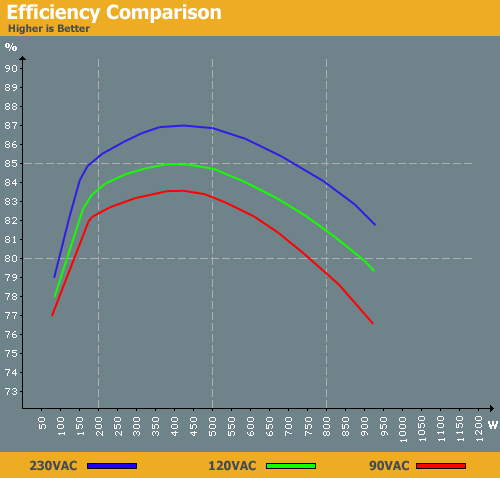
850W
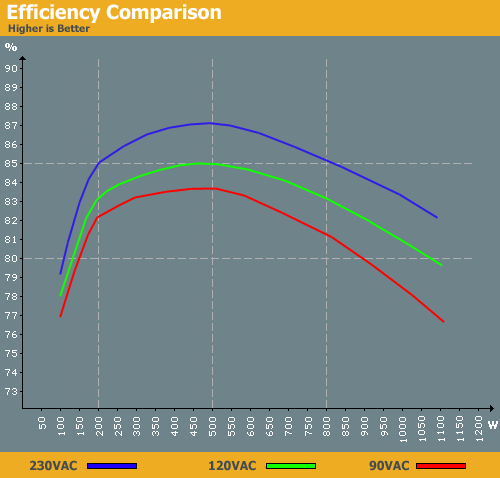
1000W
First of all the efficiency is great. With 230VAC it stays just above 85% from 180W to 700/800W of load, which is really good for a power supply. With lower input such as 120VAC it unfortunately cannot reach that same level of performance, but 83% at low load, 85% with medium load, and 82% with full load are also good results. The 1000W unit performs equally well in comparison to the 850W version, since it has almost the same efficiency with lower loads. The highest score today is 87% efficiency, reached by the 850W unit at around 400W of load and by the 1000W unit with 500W of load.
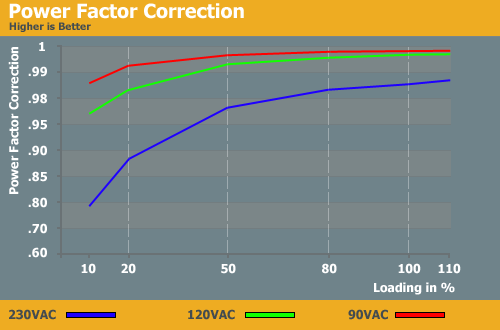
The power factor correction as usual doesn't look so good with higher input voltage. It reaches a reasonable level at high loads but it needs a long time to get on track. With 90 and 120VAC it looks quite different. Here it starts high and stays high as it should.
Fan Speed and Acoustics
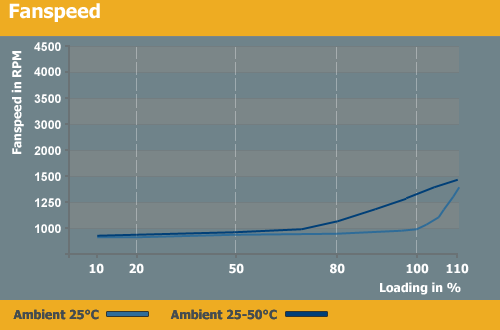
The fans of both units stay at a just below 1000RPM for most of our load levels. The fans stays at these very low rotations under room temperature throughout our loading, only spinning faster when full load is reached. We have not seen anything like this before and need to congratulate Zalman for this approach. The heatpipes and 140mm fan are doing their job and cooling the unit very well, so there is no need for faster wind speeds. 1400RPM is the fan's maximum speed, but as we will see in the next graphic it is not perfectly silent.
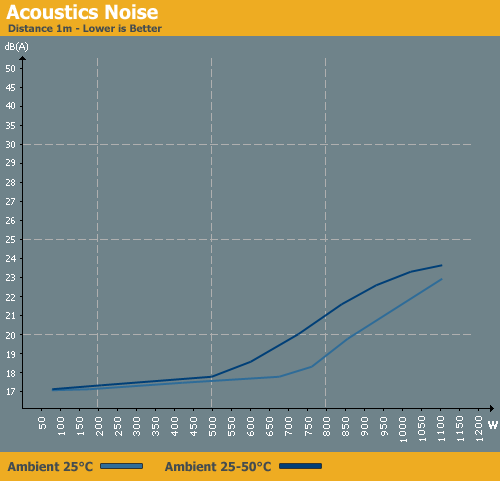
Even though the previous graphic doesn't show how the fan accelerates before full load too well, the acoustic noise levels show the results. The fan spins just a bit faster as load increases, but it produces more noise than expected. There is absolutely no noise up to 600W of load; the PSU stays at a constant 17dB(A), which is quite low and not audible running in our acoustic chamber. If the unit is installed in a PC, users will not be able to hear it at all even with higher loads.
Now all you would need is to find two or three really quiet graphics cards and a CPU cooler and your silent system would be ready for this high-power, relatively quiet PSU. Without water cooling this will prove very difficult, since the coolers for today's graphics cards have to dissipate so much heat. Overall, however, both Zalman units deliver a very good performance from the silent point of view.
Conclusion
Zalman took a long time to bring high performing units to its portfolio, and they had FSP manufacture their top models previously. It was definitely a good step to have Enhance make these new units, as they are better high performing units.
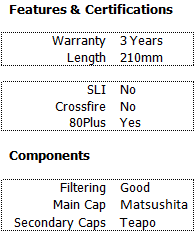 |
The build quality is very good, as we have seen with other Enhance units already. The choice of components was good in most areas, though Teapo is average in terms of quality if reputation. From the performance side we saw a few small problems with the output stability, which dropped 3% to 4%. It's not a critical flaw, but neither is it the best performance we've seen. The little "noise suppressor" gimmick on the back didn't really impress us either, since we saw better results when it was switched off.
From the efficiency side these units put on a good show, reaching up to 87% with 230VAC input. Both power supplies worked well with a long period of high efficiency, which makes them real energy savers in the fight for our decreasing natural resources. The 1000W unit was more efficient from the load and time perspective, but how many systems really need this kind of power?
The second surprise today was the acoustic noise which stayed at acceptable levels throughout our testing. Even though the fan turns quite slow, however, noise increases quickly with small RPM changes - that's typical of 140mm fans, of course. The fan is aided by the installed heatpipes, which do well at dissipating heat. With only 17dB(A) from lowest to medium load, this unit is definitely one of the quietest power supplies available today. If you compare it to our former results, it currently rates as the quietest PSU that is able to deliver more than 850W.
The ZM850-HP is available at Newegg for just $180 and in Europe it starts at 160 EUR including taxes. The lowest price for the ZM1000-HP is currently from ZipZoomFly for just $240 and in Europe it starts at 215 EUR with taxes. Comparing these prices, we recommend the 850W unit since the ZM1000-HP will not bring you real visible advantages over the ZM850-HP. If you're thinking of running a couple GeForce GT280 GTX cards, though, the 1000W model may be worth a look.

























